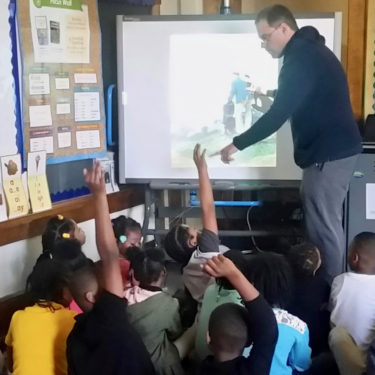Greetings! Before I begin I would like to thank you for your involvement with and interest in Visual Thinking Strategies. It is a subject that I am passionate about and I am honored to share some of my experiences using VTS in my classroom with you.
I have the privilege of teaching 2nd Grade at Sherman Multicultural Arts School in Milwaukee, Wisconsin. Last year, my class consisted of 24 second graders who, unfortunately, like the vast majority of our students at Sherman, are considered to be living in poverty. As such, we must face many challenges—inside the classroom and out—that can impede learning.1 Visual Thinking Strategies has enriched my students in a very real and documented way through the exposure to and discussion of visual art. By the end of the year, every single one of my students showed an improvement in their writing as well as an increase in their willingness and ability to explain their thinking, which I believe to be indicative of the brilliance of VTS.2 To illustrate this point, I would like to share the progress of two students who could not be more different in terms of their strengths and weaknesses. For the purpose of this essay, I will call them Mariah and Isaac.
Mariah has autism. She was nonverbal for the first four years of her life and she struggles with her speech to this day. Large groups are challenging for her because she can be overwhelmed by an excess of noise or commotion. Therefore, you might assume an activity that includes speaking in front of a large group of peers would be problematic for her; with VTS, however, just the opposite has proven to be true. Key elements of VTS encourage even the most reluctant student to share their ideas. Unfortunately, Mariah is no stranger to being misunderstood in terms of her speech and underestimated in terms of her intelligence. For this reason, paraphrasing—the element of VTS in which the facilitator carefully and accurately rephrases what the participant has said—was important; it demonstrates to everyone that the speaker has been heard and understood. This automatically validates their idea in a more meaningful and authentic way than a nonspecific compliment ever could: you can pretend to understand someone with a nod or a comment like, “Good point!” but you can’t fake a good paraphrase. The feeling of being heard and understood is affirming to anyone, but for a child who had struggled to communicate her whole life, it was nothing short of powerful! By the end of the year, I could always count on Mariah to provide her insight into what was going on in the images we viewed. In addition, many others, including her Speech Pathologist, noticed an increase in her attempts to verbally communicate and self advocate. I believe this improvement was greatly supported by VTS.
In contrast to Mariah, Isaac is an achiever for whom learning comes very easily. He is highly motivated, but shy. He is not the type of person who enjoys being singled out in front of others for his intelligence. As a result, he is hesitant to share in class. A key element of VTS facilitation, though, is for the teacher to remain open and accepting of all comments, not valuing one idea above another. VTS allowed Isaac to share his gifts without being singled out for his, at times, outstanding insights or the highly detailed and compelling rationale he offered for his opinions. This resulted in an increase in his participation in all subject areas, which I believe can be directly attributed to VTS. He also showed an increase of over 100% in the length of his written explanation of the image shown to him at the beginning of the school year versus his explanation for the same image in June. This impressed me because Isaac neither enjoys writing, nor does he feel it is his strength. VTS, in general, and the carefully chosen image in particular, motivated him to put more effort into his writing and produce what turned out to be an amazing piece of work.
In addition to these students, all the other students in my class have shown similar progress in their writing and their willingness and ability to share the reason behind their opinions, which is a highly valuable skill. To sum up, VTS has become a vital part of my instruction and I am convinced it can work for all students.
I would like to offer some advice to those of you who are new to facilitating VTS discussions. Please resist the urge to compliment the ideas of the participants, which I know can be hard at times. Refraining from using compliments feels unnatural, particularly if you are (and you will be) astounded by the insights that you hear. Also, like a journalist, always use neutral language because your personal opinion about the quality of a comment is irrelevant to the discussion and could actually end up stifling participation. Complimenting one student’s idea can be misconstrued as a criticism of another’s comment, because that individual may feel like they received less praise. Trust that your paraphrase in and of itself is more validating than verbal praise. Besides, in my mind every answer is equally valid, because art is by its nature subjective; the truth behind it lives only in the minds of each person who views it and takes the time to think about what they see.
Finally, be passionate about this work. Your enthusiasm goes a long way in improving the quality of your discussions. One does not need a background in art or journalism to succeed in facilitating VTS. If you submit to performing the task as it was intended and taught to you by your trainer, you will see powerful results; you will not be able to help being enthusiastic about it.
Art can be an amazing teaching tool and VTS can harness its ability to improve the way we experience the world and share it with others. Thank you!
Questions or comments? Contact us.
Footnotes
- 1 - It is for this reason that we at Sherman feel so fortunate to be a Turnaround Arts school. At this time I would be remiss if I didn’t give a shout out to the folks at the Kennedy Center for funding the Turnaround Arts program. Shout out!!! For those of you who are unaware, the Turnaround Arts program is designed to help underperforming schools with a variety of arts based interventions, including VTS .
- 2 - As an assessment, students write an open-ended response to an artwork at the beginning of the year and again at the end of the year. After examining the results, the length of their writing at the end of the year was, on average, almost twice as long as it had been, regardless of the child’s original ability level. And, I'm proud to report, almost every one was peppered with what I tell my students is my favorite word—“because”—followed by an explanation of what they saw in the image that made them feel the way they did. Coincidence? I think not!

